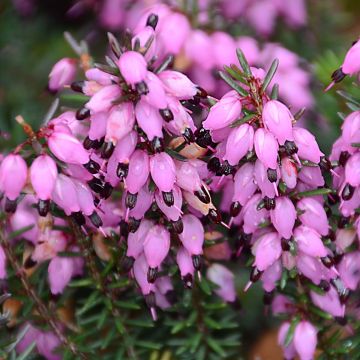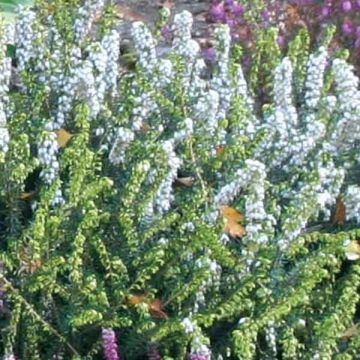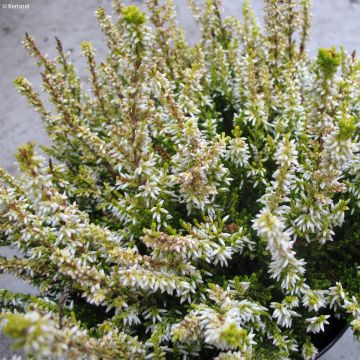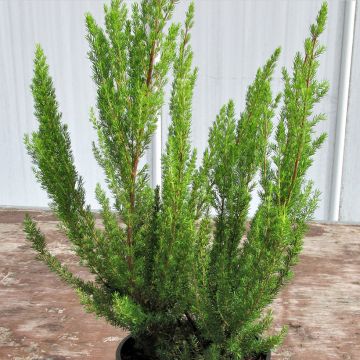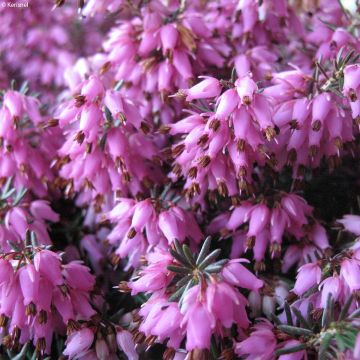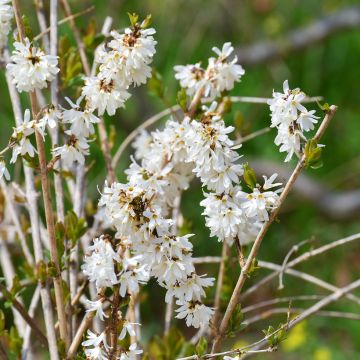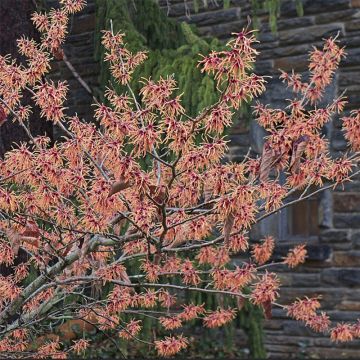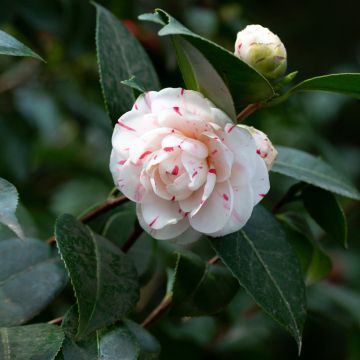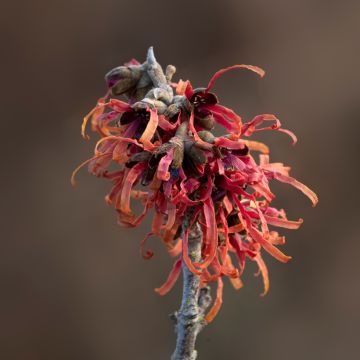

Winter Heather collection - Erica
Winter Heather collection - Erica
Erica
Heather, Winter heather
This item cannot be shipped to the selected country
Delivery charge from €5.90
More information
Schedule delivery date,
and select date in basket
This plant carries a 24 months recovery warranty
More information
We guarantee the quality of our plants for a full growing cycle, and will replace at our expense any plant that fails to recover under normal climatic and planting conditions.
From €5.90 for pickup delivery and €6.90 for home delivery
Express home delivery from €8.90.
Does this plant fit my garden?
Set up your Plantfit profile →
Collection items (3 plants)
Description
This is a collection of 3 winter heathers chosen from the best varieties at an attractive price. Erica x darleyensis 'Kramer's Rote', appreciated for its vivacity and long-lasting flowering, 'Erica carnea 'Springwood White' with its award-winning white flowers in England, and the vigorous Erica carnea 'December Red', which is covered in brilliant flowers in December. Their flowering will overlap and succeed each other from late autumn to early spring. You can plant these small evergreen shrubs in rockeries, on slopes, in raised borders, or even in pots on the terrace. They will thrive in any well-drained soil, even slightly chalky and fairly dry.
These heathers are characterised by a low and wide habit, bushy, evergreen foliage in needles and a nectar-rich flowering that renews itself for several weeks between November and April.
The collection consists of:
1 Erica x darleyensis 'Kramer's Rote': a variety reaching approximately 35 cm high and 45 cm wide, flowering between October and April depending on the climate, with small urn-shaped flowers in a very bright dark pink with brown stamens. Its dark green foliage turns bronze in the cold.
1 Erica carnea 'Springwood White': a shorter variety, reaching 25-30 cm high and 40 cm wide. Abundant white flowering between December and April on a bright green foliage.
1 Erica carnea 'December Red': its dimensions are comparable to those of 'Springwood White'. It also flowers abundantly between December and April, depending on the climate. Its flowers change from bright carmine-pink to purple. Its foliage is dark green.
The heathers in this collection are hardy and undemanding in terms of soil, easy to grow in the sun in any well-drained soil without excessive chalk. Once well established, they can withstand anything after careful planting, and watering for the first two years. During planting, we recommend loosening the root ball a little, cutting any long roots, and planting in a hole measuring 30 x 30 cm, filled with a mixture of organic matter, ericaceous soil, and garden soil. Allow for 4 plants per m².
This collection forms the basis of a heather bed or a large border, mixed with other varieties to stagger the flowerings. These evergreen shrubs make excellent ground cover, either alone or planted among dwarf creeping conifers such as Juniperus squamata 'Blue Star', Juniperus horizontalis 'Blue Chip', or Juniperus repanda.
Report an error about the product description
Plant habit
Flowering
Foliage
Botanical data
Erica
Ericaceae
Heather, Winter heather
Cultivar or hybrid
Other Heather
Planting and care
Winter heather enjoys full sun, which improves its flowering, and can grow in any type of soil, even clayey or slightly chalky, as long as it is well-drained and deeply loosened. Once well-established, it can withstand anything, but its planting must be careful and watering should be maintained during the first two years: if the root ball dries out while the root system is still underdeveloped, the plant will die. Conversely, waterlogged soil, especially in hot weather, can promote the development of a fungus called Phytophthora which, once established, will overcome this heather.
During planting, it is advisable to break the root ball a little, trim any excessively long roots, and plant in a hole measuring 30x30 cm, filled with a mixture of organic matter, ericaceous soil, and garden soil. Water it once or twice a week depending on the ambient temperature, to keep the soil moist while the plant establishes itself. To maintain a compact habit and increase the lifespan of the heather, it is useful, every year after flowering, to prune back the faded branches to 2-5 cm from the previous year's growth, making sure not to cut below the last green leaves. Erica can also be susceptible to phythium and rhizoctonia during hot and humid periods. Fertiliser is not necessary, in fact, it is not recommended to avoid promoting foliage production at the expense of flowering (heathers are generally plants of poor soils).
Planting period
Intended location
Care
This item has not been reviewed yet - be the first to leave a review about it.
Winter-flowering shrubs
Haven't found what you were looking for?
Hardiness is the lowest winter temperature a plant can endure without suffering serious damage or even dying. However, hardiness is affected by location (a sheltered area, such as a patio), protection (winter cover) and soil type (hardiness is improved by well-drained soil).

Photo Sharing Terms & Conditions
In order to encourage gardeners to interact and share their experiences, Promesse de fleurs offers various media enabling content to be uploaded onto its Site - in particular via the ‘Photo sharing’ module.
The User agrees to refrain from:
- Posting any content that is illegal, prejudicial, insulting, racist, inciteful to hatred, revisionist, contrary to public decency, that infringes on privacy or on the privacy rights of third parties, in particular the publicity rights of persons and goods, intellectual property rights, or the right to privacy.
- Submitting content on behalf of a third party;
- Impersonate the identity of a third party and/or publish any personal information about a third party;
In general, the User undertakes to refrain from any unethical behaviour.
All Content (in particular text, comments, files, images, photos, videos, creative works, etc.), which may be subject to property or intellectual property rights, image or other private rights, shall remain the property of the User, subject to the limited rights granted by the terms of the licence granted by Promesse de fleurs as stated below. Users are at liberty to publish or not to publish such Content on the Site, notably via the ‘Photo Sharing’ facility, and accept that this Content shall be made public and freely accessible, notably on the Internet.
Users further acknowledge, undertake to have ,and guarantee that they hold all necessary rights and permissions to publish such material on the Site, in particular with regard to the legislation in force pertaining to any privacy, property, intellectual property, image, or contractual rights, or rights of any other nature. By publishing such Content on the Site, Users acknowledge accepting full liability as publishers of the Content within the meaning of the law, and grant Promesse de fleurs, free of charge, an inclusive, worldwide licence for the said Content for the entire duration of its publication, including all reproduction, representation, up/downloading, displaying, performing, transmission, and storage rights.
Users also grant permission for their name to be linked to the Content and accept that this link may not always be made available.
By engaging in posting material, Users consent to their Content becoming automatically accessible on the Internet, in particular on other sites and/or blogs and/or web pages of the Promesse de fleurs site, including in particular social pages and the Promesse de fleurs catalogue.
Users may secure the removal of entrusted content free of charge by issuing a simple request via our contact form.
The flowering period indicated on our website applies to countries and regions located in USDA zone 8 (France, the United Kingdom, Ireland, the Netherlands, etc.)
It will vary according to where you live:
- In zones 9 to 10 (Italy, Spain, Greece, etc.), flowering will occur about 2 to 4 weeks earlier.
- In zones 6 to 7 (Germany, Poland, Slovenia, and lower mountainous regions), flowering will be delayed by 2 to 3 weeks.
- In zone 5 (Central Europe, Scandinavia), blooming will be delayed by 3 to 5 weeks.
In temperate climates, pruning of spring-flowering shrubs (forsythia, spireas, etc.) should be done just after flowering.
Pruning of summer-flowering shrubs (Indian Lilac, Perovskia, etc.) can be done in winter or spring.
In cold regions as well as with frost-sensitive plants, avoid pruning too early when severe frosts may still occur.
The planting period indicated on our website applies to countries and regions located in USDA zone 8 (France, United Kingdom, Ireland, Netherlands).
It will vary according to where you live:
- In Mediterranean zones (Marseille, Madrid, Milan, etc.), autumn and winter are the best planting periods.
- In continental zones (Strasbourg, Munich, Vienna, etc.), delay planting by 2 to 3 weeks in spring and bring it forward by 2 to 4 weeks in autumn.
- In mountainous regions (the Alps, Pyrenees, Carpathians, etc.), it is best to plant in late spring (May-June) or late summer (August-September).
The harvesting period indicated on our website applies to countries and regions in USDA zone 8 (France, England, Ireland, the Netherlands).
In colder areas (Scandinavia, Poland, Austria...) fruit and vegetable harvests are likely to be delayed by 3-4 weeks.
In warmer areas (Italy, Spain, Greece, etc.), harvesting will probably take place earlier, depending on weather conditions.
The sowing periods indicated on our website apply to countries and regions within USDA Zone 8 (France, UK, Ireland, Netherlands).
In colder areas (Scandinavia, Poland, Austria...), delay any outdoor sowing by 3-4 weeks, or sow under glass.
In warmer climes (Italy, Spain, Greece, etc.), bring outdoor sowing forward by a few weeks.




































